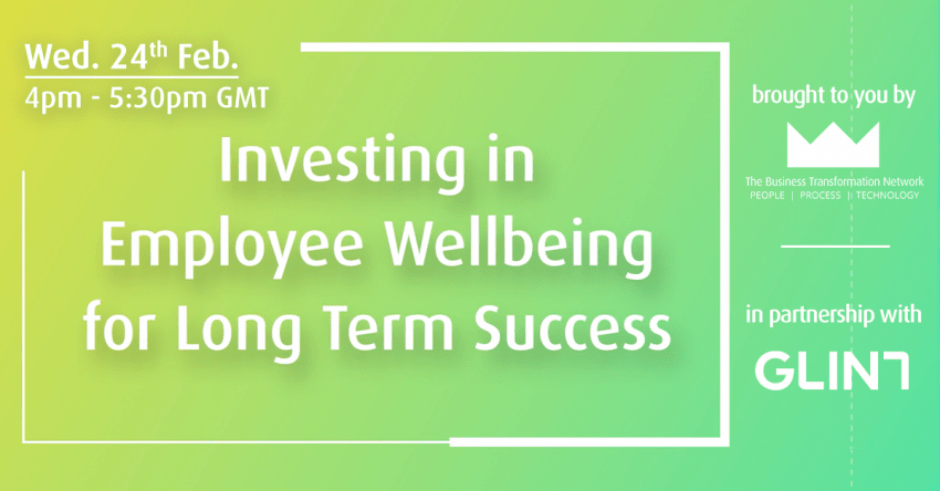We recently hosted a virtual roundtable in partnership with Glint on ‘Investing in Employee Wellbeing for Long Term Success’. The conversation covered a variety of aspects in the wellbeing space focusing on the strategies and stories we can use to further develop well-being initiatives.
Your employees are integral. If your people succeed, your organisation becomes successful too and well-being needs to be the core of that. In a business world where employees are feeling less and less ‘connected’ how do we ensure that their work-life balance is optimised? What role do leaders play in this? How can organisations enable their leaders to have conversations remotely and best understand their employees’ needs?
The key takeaways from the conversation were the following:
Frequent data collection provides the insight you need
It was widely agreed that using data and insights can give you an understanding into the way others are thinking and feeling. All attendees said that they had been collecting data on employee engagement and well-being more frequently since the pandemic as it was harder to keep people engaged whilst remote, or furloughed etc. This data tended to result in valuable findings across the board, one of which recognised people’s emotions and well-being seemed to fall in patterns of peaks and troughs, which could be hard to regulate. As organisations have recognised these peaks and troughs, they can change their approach to best suit the scenario their people are dealing with.
Preventing burnout
One of the biggest issues for well-being in the current working environment is burnout. It was revealed that employees were 2.1 times more likely to experience burnout if they thought their organisation struggled to communicate during times of change.
Feedback is also key to preventing burnout. When leaders get even closer to employee feedback, and ask for it more frequently, they’re better positioned to counteract the burnout levels we’re seeing—no matter how an employee identifies or what industry they’re in.
Organizations best support their employees when they:
- Ask for frequent feedback.
- Reinforce shared culture and values.
- Arm managers with feedback results.
- Empower managers to have conversations with employees so they can find specific solutions for unique circumstances.
Communication is integral for wellbeing
Well-being and flexibility often go hand in hand and can be an enormous game-changer, but when most organisations say flexible working, what they actually mean is remote working… Well-being has become as much about safety (physical, psychological and mental) and financial security, as anything else. Organisations need to remember that they are catering to a variety of employee groups and you cannot apply a one size fits all approach to their well-being. Communicating well-being initiatives in a number of ways for the different groups within an organisation (IE. those that are working remote, and those that are onsite) can make all the difference. As a general rule, information needs to be easily accessible and simple for people to obtain.
Don’t forget to check-in
Being open and providing spaces where people can talk to their peers or business leaders about how they are feeling is important. To start with, it appeared management didn’t feel equipped to have the conversations that were needed to check on employee’s well-being. Teaching people how to deal with these types of conversation is integral to employee well-being and psychological safety.
In Glint’s experience, organisations that are doing the best job of fostering connection among their employees are thinking differently. They are giving employees a voice through frequent feedback pulses. What one group needs for connection or to overcome burnout is likely different from another. For example, a knowledge worker logging countless hours from home may be concerned about prioritization and workload. But an essential worker may be more worried about threats to health and safety. Understanding employees’ unique experiences is the best way to build strategies for creating connections and overcoming burnout.
Taking the above into account, it is really important to stress that there isn’t a one-size-fits-all approach to any of this. We’re all learning as we go, facing issues in similar ways and there has been a steep learning curve for organisations and leaders on how to best help their people through this difficult time. It is important that organisations recognise the role mental health and well-being play concerning employee health, engagement and retention. In addition to this, organisations need to prepare their leaders to have the conversations they need to fulfil their duty of care. Well-being is everyone’s top priority at the moment, but it is important that it stays like that as organisations begin to navigate the return to the workplace.
Glint is the people success platform that leverages real-time people data to help global organizations increase employee engagement, develop their people, and improve results. Leading brands like United, Intuit, and Sky leverage Glint’s unique combination of intuitive design, sophisticated analytics, and actionable intelligence to help employees be happier and more successful at work.

